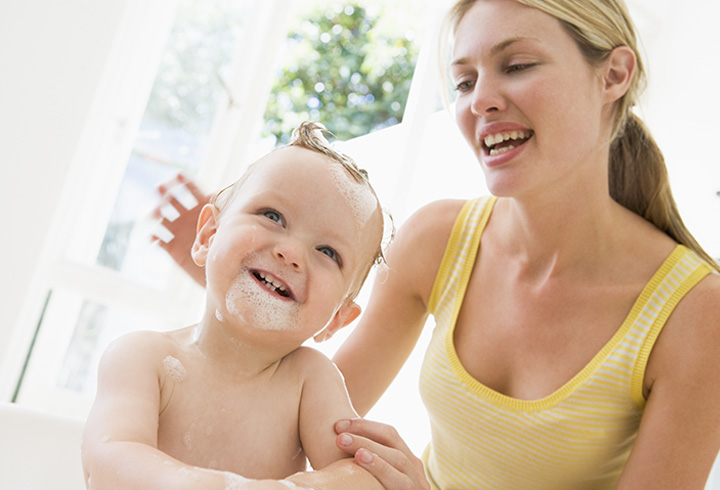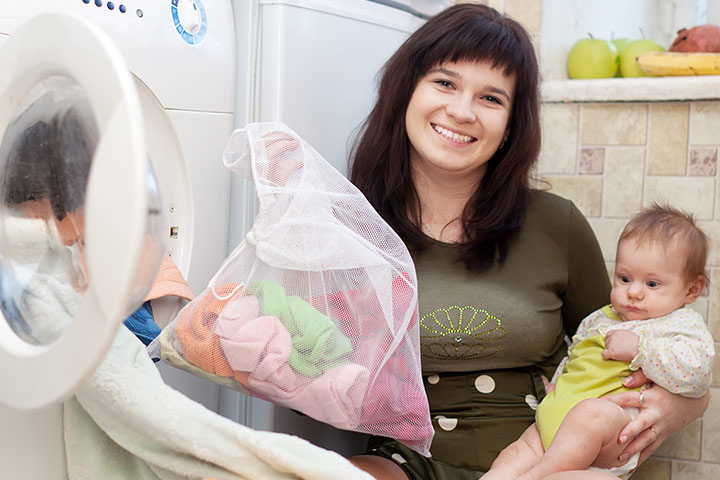As a parent, it makes sense to be concerned about chemicals your baby may be exposed to. Unfortunately, many chemicals hide in plain sight, turning up in seemingly innocent places such as bath products. Even soaps, body washes and bubble baths labeled “natural” may contain ingredients that could have a negative impact on health.
What’s Hiding in Your Baby’s Bath?
Most popular baby body washes include a laundry list of chemical additives. Irritation of the skin, eyes and respiratory system is the most common trio of problems that babies experience due to these chemicals. Eczema, asthma, allergies and other conditions may be exacerbated every time you give your baby a bath. Sodium laureth sulfate (SLS) in particular may be a culprit in skin reactions. It’s a known skin irritant and yet turns up in many baby and adult bath products as a way to promote lathering.
Some soaps and washes claiming to be “gentle” may contain SLS and other ingredients such as parabens. According to the Environmental Working Group (EWG), parabens are known to cause allergic reactions, especially in the skin. Since babies have the most sensitive skin of all, anything that may trigger uncomfortable conditions should be avoided.
A 1998 British study found that parabens also mimic estrogen in the body. Although they’re weaker than natural estrogens, it’s possible that they could promote imbalances that affect a baby’s development. The EWG classifies parabens as “endocrine disruptors” and warns against use due to potential “developmental or reproductive toxicity.”
Fragrances and perfumes used to make body washes smell good cling to your baby’s skin for hours after a bath. According to Dr. Frank Lipman, the word “fragrance” on a label may indicate the presence of one or more of over 4,000 different chemicals. Most of these chemicals are synthetic and are classified by the EWG as potential allergens and skin toxicants. Tests have shown many fragrances to be potential carcinogens. Seeking out fragrance-free baby products is the best way to avoid reactions since you never know which chemicals you’re getting when fragrances are used.
Some chemicals don’t appear on labels at all because they form as by-products of other ingredients. For example, 1,4-dioxane, which the Environmental Working Group (EWG) has discovered in as much as 54 percent of all baby soaps, is produced from ethylene oxide. Ethylene oxide is used to reduce the harshness of other chemical additives but is classified as dangerous by the EWG. Both ethylene oxide and 1,4-dioxane can cause symptoms in the skin, eyes or lungs and are implicated as carcinogens.
Propylene glycol, another common ingredient in bath products, is often contaminated with both ethylene oxide and 1,4-dioxance. According to TreeHugger.com, this means that the presence of propylene glycol makes a product potentially carcinogenic. The same source points out that DEA, an emulsifier and foaming agent found in many body washes, should be avoided for the same reasons.
You may have heard that some popular baby washes contain formaldehyde. While this isn’t strictly true since the chemical isn’t added directly to the formula, it may be released over time from other ingredients. In addition to the potential for causing irritation, chronic exposure to formaldehyde may result in reproductive problems and the development of cancers.
Making Bath Time Natural
Knowing what to look for and what to avoid in baby body wash can help you choose products that are truly safe for your baby. The first step in cleaning up bath time is to become a discerning label reader. Just like there’s a lot of “greenwashing” with home cleaning products, there are a lot of false claims made by companies producing “natural” products. There is little or no regulation for this term, meaning that manufacturers don’t have to meet any particular standard in order to use the word in their marketing.
Look for products that are not only free of common additives but also of ingredients you don’t recognize. If something confuses you, look it up in a directory such as the Good Guide or the Skin Deep database from the EWG, both of which use numbered scales and color coding systems to indicate the safety of products and their ingredients. Don’t be surprised if some brands that you thought were safe receive a low rating. According to the Organic Consumers Association, many products that claim to be “green” or environmentally friendly contain carcinogenic compounds that neither you nor your baby should be exposed to.
Cleaning Up Your Routine
Keep in mind as you shop for safe baby wash and other products that babies are much more sensitive to chemical exposure than adults are. The systems within their bodies that are meant to protect against and detox from chemicals aren’t fully developed and therefore not equipped to handle a high toxic load. Ensuring a safe, natural bath time is just one way that you can keep your child safe from the potential effects of toxic exposure and promote health as they grow.
Fortunately it’s not hard to find chemical-free bath products for your baby. Look for labels that specify the formula is free of fragrances, parabens and other common chemicals. After a little practice reading labels, you’ll be able to identify safe products at a glance. Build a core collection of favorites that are safe for your baby and enjoy every bath time free from worry.


